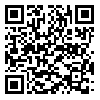شمارۀ جدید فصلنامه (پاییز1404) منتشر شد
Volume 14, Issue 1 (10-2023)
Social Problems of Iran 2023, 14(1): 135-162 |
Back to browse issues page
Download citation:
BibTeX | RIS | EndNote | Medlars | ProCite | Reference Manager | RefWorks
Send citation to:



BibTeX | RIS | EndNote | Medlars | ProCite | Reference Manager | RefWorks
Send citation to:
Enayat H, Zare H. (2023). Qualitative analysis of the early child marriage experiences in secondary schools in Meimand city. Social Problems of Iran. 14(1), 135-162. doi:10.61186/jspi.14.1.135
URL: http://jspi.khu.ac.ir/article-1-3627-en.html
URL: http://jspi.khu.ac.ir/article-1-3627-en.html
1- , hzare775@gmail.com
Abstract: (2400 Views)
The purpose of the current research is to qualitatively analyze the early child marriage experiences of married teenage students in secondary school in Maimand city. This study is part of the interpretive paradigm and its nature is qualitative, and it was conducted with the method of grounded theory with the approach of Strauss and Corbin. First, through purposive sampling and then theoretical sampling, in-depth interviews were conducted with 15 students of the first and second high schools who got married at the age of less than eighteen years. Simultaneously with data collection, coding and analysis of findings were done. The findings include: 62 sub themes; The 12 main themes and central theme are under the title of early child marriage as "lack of voice and agency" of female students. The results of this research showed that in the traditional and tribal context where girls live and under the intervening conditions of identity crisis during adolescence, early child marriage occurs at school ages. The causal conditions that play a role in the occurrence of this phenomenon are: patriarchy, economic problems and poverty, and the chaotic environment of the girl's family. The actions that were presented in response to the phenomenon of early child marriage include: sexual experience, academic challenges, mother's child, domestic violence, and psychological effects. The consequences of early child marriage have also occurred in the form of disordered married life and divorce at teenage ages.
Type of Article: Original Research |
Subject:
Family & Marriage
Received: 2023/08/10 | Accepted: 2023/09/30 | Published: 2023/10/9
Received: 2023/08/10 | Accepted: 2023/09/30 | Published: 2023/10/9
References
1. Asadullah, MN., & Wahhaj, Z. (2019). Early marriage, social networks and the transmission of norms. Economica, 86(34), 801-831. [DOI:10.1111/ecca.12291]
2. https://doi.org/10.1111/ecca.12291 [DOI:10.1111/ecca.12291.]
3. Asna-ashary, M., Farzanegan, M.R., Feizi, M., & Gholipour, H.F. (2020). Socio-Economic Determinants of Child Marriage: Evidence from the Iranian Provinces. CESifo Working Paper No. 8073. http://dx.doi.org/10.2139/ssrn.3535283. [DOI:10.2139/ssrn.3535283]
4. Barnett, O. W., Perrin, C. L., & Perrin, R. D. (1997). Family violence across the lifespan: An introduction. Thousand Oaks, CA: Sage Publications.
5. Beaman, L., Duflo, E., Pande, R., & Topalova, P. (2012). Female leadership raises aspirations and educational attainment for girls: A policy experiment in India. Science, 335(6068), 582-586.
https://doi.org/10.1126/science.1212382 [DOI:10.1126/science.1212382.]
6. Bhuwania, P., Huh, K., & Heymann, J. (2023). Impact of Tuition-Free Education Policy on Child Marriage and Early Childbearing: Does Secondary Matter More? Population and Development Review 49(1), 43-70.
https://doi.org/10.1111/padr.12538 [DOI:10.1111/padr.12538.]
7. Botea, I., Chakravarty, Sh., Haddock, S., & Wodon, Q. (2017). Interventions Improving Sexual and Reproductive Health Outcomes and Delaying Child Marriage and Childbearing for Adolescent Girls. Ending Child Marriage Notes Series.Washington, DC: World Bank Group.
8. Boyle, M.H., Racine, Y., & Georgiades, K. et al. (2006). The Influence of Economic Development Level, Household Wealth and Maternal Education on Child Health in the Developing World. Social Science & Medicine 63 (8), 2242-2254. [DOI:10.1016/j.socscimed.2006.04.034]
9. Hotchkiss, D.R., Godha, D., & Gage, A.J. et al. (2016). Risk factors associated with the practice of child marriage among Roma girls in Serbia. BMC Int Health Hum Rights 16,
https://doi.org/10.1186/s12914-016-0081-3 [DOI:10.1186/s12914-016-0081-3.]
10. Jones, N., Presler-Marshall, El., Kassahun, G., & Hateu, M.K. (2020). Constrained choices: Exploring the complexities of adolescent girls’ voice and agency in child marriage decisions in Ethiopia. Progress in Development Studies, 20(4), 296-311. [DOI:10.1177/1464993420958215]
11. Kabeer, N., & Sulaiman, M. (2015). Assessing the impact of social mobilization: Nijera Kori and the construction of collective capabilities in rural Bangladesh. Journal of Human Development and Capabilities 16(1), 47-68. [DOI:10.1080/19452829.2014.956707]
12. Kenny, L., Koshin, H., Sulaiman, M., & Cislaghi, B. (2019). Adolescent-led marriage in Somaliland and Puntland: A surprising interaction of agency and social norms. Journal of Adolescence, 72, 101-111. [DOI:10.1016/j.adolescence.2019.02.009]
13. Klugman, J., Hanmer, L., Twigg, S., Hasan, T., & McCleary-Sills, J. (2014). Voice and Agency: Empowering Women and Girls for Shared Prosperity. Washington, DC: The World Bank. [DOI:10.1596/978-1-4648-0359-8]
14. Malhotra, A., Warner, A., McGonagle, A., & Lee-Rife, S. (2011). Solutions to End Child Marriage What the Evidence Shows. Washington, DC: International Center for Research on Women.
15. McDougal, L., Jackson, E. C., McClendon, K. A., Belayneh, Y., Sinha, A., & Raj, A. (2018). Beyond the statistic: exploring the process of early marriage decision-making using qualitative findings from Ethiopia and India. BMC women's health, 18(1), 1-16. [DOI:10.1186/s12905-018-0631-z]
16. https://doi.org/10.1186/s12905-018-0631-z [DOI:10.1186/s12905-018-0631-z.]
17. Nour, N.M. (2006). Health Consequences of Child Marriage in Africa. Emerging Infectious Diseases 12(11), 1644-1649.
https://doi.org/10.3201/eid1211.060510 [DOI:10.3201%2Feid1211.060510.]
18. Parsons, J., Edmeades, J., & Kes, A. et al. (2015). Economic Impacts of Child Marriage: A Review of the Literature. The Review of Faith & International Affairs 13(3), 12-22. [DOI:10.1080/15570274.2015.1075757]
19. Petroni, S., Steinhaus, M., & Stevanovic, N. et al. (2017). New Findings on Child Marriage in Sub-Saharan Africa. Annals of Global Health 83(5-6), 781-790. [DOI:10.1016/j.aogh.2017.09.001]
20. Plan UK. (2011). Breaking Vows: Early and Forced Marriage and Girls' Education. London: Plan UK.
21. Raj, A., Saggurti, N., & Winter, M. et al. (2010). The Effect of Maternal Child Marriage on Morbidity and Mortality of Children Under 5 in India: Cross Sectional study of a Nationally Representative Sample. BMJ 340: b4258. [DOI:10.1136/bmj.b4258]
22. Ramaswami, R., & Mackiewicz, A. (2009). Scaling Up: Why Women-Owned Businesses Can Recharge the Global Economy. New York: Ernst and Young.
23. Semba, R.D., de Pee, S., & Sun, K., et al. (2008). Effect of Parental Formal Education on Risk of Child Stunting in Indonesia and Bangladesh: A Cross-sectional Study. The Lancet, 371(9609), 322-328. [DOI:10.1016/S0140-6736(08)60169-5]
24. Sembiring, A. A. R. B., Safitri, E. P., Tarigan, N. V., Salamah, S., & Afiq, M. F. (2023). Psychological Impact Evaluation of Early Marriage. JURNAL EDUKASI NONFORMAL, 4(1), 18-21. Retrieved from https://ummaspul.e-journal.id/JENFOL/article/view/5514.
25. Stark, L. (2018). Poverty, Consent, and Choice in early Marriage: Ethnographic Perspectives from Urban Tanzania. Marriage & Family Review 54(6): 565-581. [DOI:10.1080/01494929.2017.1403998]
26. UNICEF. (2005). Early Marriage a Harmful Traditional Practice a Statistical Exploration. New York: UNICEF.
27. UNICEF. (2019). Child marriage.
28. Available at: https://www.unicef.org/protection/child-marriage.
29. Vogelstein, R. (2013). Ending Child Marriage: How Elevating the Status of Girls Advances U.S. Foreign Policy Objectives. New York: Council on Foreign Relations.
30. WHO. (2003). Towards Adulthood: Exploring the Sexual and Reproductive Health of Adolescents in South Asia. Geneva: World Health Organization.
Send email to the article author
| Rights and permissions | |
 |
This work is licensed under a Creative Commons Attribution-NonCommercial 4.0 International License. |








